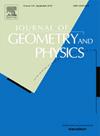用李对称方法求两个非线性椭圆型偏微分方程系统的微分不变量
IF 1.2
3区 数学
Q1 MATHEMATICS
引用次数: 0
摘要
李氏对称方法通过识别保持其结构的连续变换,为分析和求解微分方程提供了一种系统的方法。本文利用李氏对称技术研究了一类二阶非线性椭圆型偏微分方程。我们计算了系统的等价变换,这是推导微分不变量的基础。具体地说,我们建立了在因变量和自变量变换下得到的联合微分不变量,以及仅由因变量变换得到的半微分不变量。这些不变量在将系统简化为尽可能简单的形式同时保留其基本特征方面起着至关重要的作用。利用这些微分不变量,我们给出了各种非线性椭圆型偏微分方程组的约简形式,证明了该方法在简化复杂方程方面的有效性。我们的研究结果突出了李对称分析在推导不变结构和促进系统约简耦合非线性偏微分方程系统中的应用。本文章由计算机程序翻译,如有差异,请以英文原文为准。
Differential invariants of systems of two nonlinear elliptic partial differential equations by Lie symmetry method
The Lie symmetry method offers a systematic approach for analyzing and solving differential equations by identifying continuous transformations that preserve their structure. In this study, we investigate a general system of two nonlinear second-order elliptic partial differential equations using Lie symmetry techniques. We compute the equivalence transformations for the system, which serve as the foundation for deriving differential invariants. Specifically, we establish both joint differential invariants that are obtained under transformations of dependent and independent variables along with semi-differential invariants, derived solely from transformations of dependent variables. These invariants play a crucial role in reducing the system to its simplest possible form while retaining its essential features. By applying these differential invariants, we present reduced forms of various nonlinear systems of elliptic partial differential equations, demonstrating the effectiveness of the method in simplifying complex equations. Our results highlight the utility of Lie symmetry analysis in deriving invariant structures and facilitating the systematic reduction of coupled nonlinear systems of partial differential equations.
求助全文
通过发布文献求助,成功后即可免费获取论文全文。
去求助
来源期刊

Journal of Geometry and Physics
物理-物理:数学物理
CiteScore
2.90
自引率
6.70%
发文量
205
审稿时长
64 days
期刊介绍:
The Journal of Geometry and Physics is an International Journal in Mathematical Physics. The Journal stimulates the interaction between geometry and physics by publishing primary research, feature and review articles which are of common interest to practitioners in both fields.
The Journal of Geometry and Physics now also accepts Letters, allowing for rapid dissemination of outstanding results in the field of geometry and physics. Letters should not exceed a maximum of five printed journal pages (or contain a maximum of 5000 words) and should contain novel, cutting edge results that are of broad interest to the mathematical physics community. Only Letters which are expected to make a significant addition to the literature in the field will be considered.
The Journal covers the following areas of research:
Methods of:
• Algebraic and Differential Topology
• Algebraic Geometry
• Real and Complex Differential Geometry
• Riemannian Manifolds
• Symplectic Geometry
• Global Analysis, Analysis on Manifolds
• Geometric Theory of Differential Equations
• Geometric Control Theory
• Lie Groups and Lie Algebras
• Supermanifolds and Supergroups
• Discrete Geometry
• Spinors and Twistors
Applications to:
• Strings and Superstrings
• Noncommutative Topology and Geometry
• Quantum Groups
• Geometric Methods in Statistics and Probability
• Geometry Approaches to Thermodynamics
• Classical and Quantum Dynamical Systems
• Classical and Quantum Integrable Systems
• Classical and Quantum Mechanics
• Classical and Quantum Field Theory
• General Relativity
• Quantum Information
• Quantum Gravity
 求助内容:
求助内容: 应助结果提醒方式:
应助结果提醒方式:


